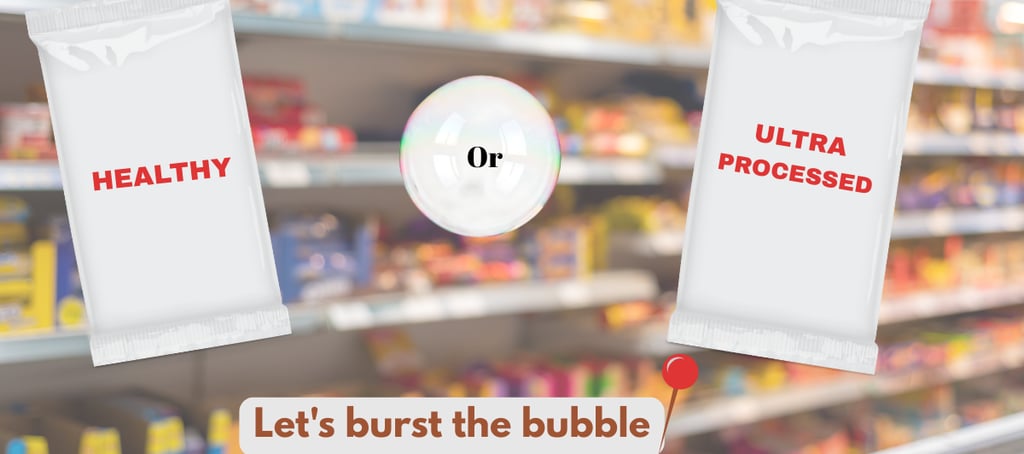Healthy Snacking or Just Clever Marketing?
How Ultra-Processed Foods Are Outrunning India’s Food Rules
FMCG


After a long day or a tough workout, it feels good to reach for something “guilt-free”.
The pack looks clean and minimal.
It says baked, multigrain, no maida, maybe even high protein.
There’s green on the label, a few grains on the front, maybe a health-related graphic somewhere.
It looks like a better choice.
Until you flip it.
The ingredient list reads like a chemistry experiment: refined oils, added sugars under multiple names, stabilizers, emulsifiers and artificial flavors. What looked like a healthy snack is, in reality, another ultra-processed product with a wellness filter on top.
This is exactly where a lot of Indian consumers are today:
Thinking they’re eating healthier.
Actually just eating smarter-marketed ultra-processed foods.
And this isn’t just a consumer problem. It’s a regulatory problem.
India’s New Dietary Guidelines vs. What’s Actually on Shelves
In 2024, India’s updated dietary guidelines (ICMR–NIN) clearly advised people to:
Avoid ultra-processed foods (UPFs)
Limit foods high in fat, sugar and salt (HFSS)
Public health experts, doctors and nutritionists are aligned: high UPF intake is strongly linked to obesity, diabetes and other lifestyle diseases.
On the regulatory side, FSSAI is supposed to be the guardrail:
It sets standards for what can go into our food
It defines how labels should behave
It is working on front-of-pack nutrition labelling (FOPNL) and stricter rules for claims and disclosures
But here’s the gap:
The science and guidelines have moved ahead
The market has raced ahead even faster
The law and its enforcement are still catching up
So we now have a situation where “healthy” branding has exploded faster than clear, enforceable standards on UPFs and HFSS foods.
The Front of the Pack Sells the Story. The Back of the Pack Holds the Evidence.
Most people don’t read Regulation Numbers. They read stories.
And the front of the pack is where that story is told.
We quickly scan:
Colours and imagery
Big bold words: baked, ragi, oats, quinoa, multigrain
Seals, stamps, icons and small green cues that “feel” safe
Our brain does the rest.
We automatically assume:
“This must be better than regular chips or biscuits.”
“This looks okay for daily snacking.”
“This is allowed even if I’m trying to eat clean.”
But if you follow what FSSAI and other health bodies actually recommend, the truth lies behind the pack, not in front of it:
Ingredient order tells you what the product really is made of
Repeated sugar sources show up in different names
Salt and fat aren’t always obvious unless you read the nutrition table
Additives, stabilizers and artificial flavors reveal how heavily engineered the product is.
This is the core mismatch:
The regulatory intent is to protect consumers. The marketing intent is to persuade them. The space between the two is where confusion lives.
When Brand Names Start to Look Like Claims
We’ve already seen how this can go wrong.
A popular packaged food brand recently came under fire because its product name and front-of-pack language created the impression of being “fresh” and “more natural”, while the back-of-pack details told a different story.
Technically, the brand could argue:
“It’s just a registered name.”
“We have added the necessary clarifications in fine print.”
But from a consumer and regulator lens, the questions are very different:
Is the overall impression misleading?
Can the average buyer reasonably misunderstand this as a health or quality claim?
Does the name conflict with the spirit of food safety and fair labelling?
This is exactly why FSSAI, courts, policy makers and public-interest groups have been talking about:
Stricter checks on misleading names and visuals
Stronger front-of-pack warnings for HFSS foods
Clearer guardrails around health and nutrition claims
Because at some point, “creative branding” crosses over into consumer deception, even if every line of the label is technically “compliant”.
The Regulatory Pressure Cooker: Why FMCG Can’t Ignore This Anymore
There are three forces closing in on ultra-processed “healthy” products in India:
Public Health Guidelines
ICMR–NIN has taken a clear position against UPFs and HFSS foods as part of everyday diets.
Global frameworks (like WHO) are pushing for warning labels and stricter ad rules, especially for kids.
Regulators & Policy Makers
FSSAI has been working on front-of-pack labelling, starred or warning-style systems and stronger norms for claims.
Task forces, expert committees and draft notifications keep coming back to one theme: simple, visible, honest information on sugar, salt and fat.
Court cases and public-interest petitions keep the pressure on, especially when big brands are seen as crossing the line.
Public Scrutiny & Social Media
Nutritionists, doctors and food scientists now decode labels publicly.
Misleading packs go viral for the wrong reasons.
A product that passes legal scrutiny may still fail the trust test overnight.
For brands, this means the question isn’t just “Is this legally allowed?” anymore. It is also:
“If FSSAI tightens rules tomorrow, will this product and this packaging still stand?”
Why Consumers Feel Cheated – And Why That Matters
From a consumer point of view, the experience is simple:
They are trying to avoid HFSS foods
They have heard of ultra-processed foods
They pick what looks like the “better” option
Then they discover it’s basically the same thing in nicer clothes
That’s where trust breaks.
From a regulator’s point of view, that gap in perception is exactly what food law is supposed to prevent.
When packaging creates the impression of health but the formulation is still ultra-processed and high in fat, sugar or salt, it defeats:
The purpose of dietary guidelines
The intent behind labelling regulations
The broader public-health agenda
What “Better-for-You” Should Mean in a Regulated World
If we align with what FSSAI, ICMR–NIN and global public health bodies are moving towards, a genuinely “better-for-you” product should:
Have short, clean ingredient lists with familiar, kitchen-level ingredients
Be honest about sugar, salt and fat – no label games across multiple sweeteners
Use brand names and claims that match reality, not just aspiration
Keep additives and ultra-processing to a minimum
Make it easy for consumers to understand:
“Is this okay every day?” or
“Is this an occasional treat?”
That’s not just good ethics. It’s a future-proofing strategy.
Because as food laws tighten and front-of-pack labels become harsher and more visual, brands that have relied on loopholes and clever language will struggle.
Where Do We Go From Here?
For consumers, the rule is simple:
Don’t stop at the front. Flip the pack.
See what the first 3–4 ingredients are.
Look at how many things you don’t recognise.
Treat multiple forms of sugar as one big red flag.
Ask yourself honestly: “Is this food or just an edible product?”
For brands and founders, the question is tougher but necessary:
Are we building a truly better-for-you product,
or are we just playing within the grey zones of current regulation?
Because the direction of travel is clear:
Guidelines are getting stricter.
FSSAI is under more scrutiny.
Public patience for “health-washed” UPFs is shrinking.
The Bottom Line
The front of the pack tells a story.
The back of the pack tells the facts.
And regulators are slowly pushing India towards a world where those two finally match.
Healthy snacking will only become real when:
Consumers demand honesty,
Brands design for both health and compliance and
Governing bodies like FSSAI have the tools and teeth to enforce it.
Until then, the best protection you have is a simple habit:
So - Healthy or ultra-processed?
Flip the pack and burst the bubble.


